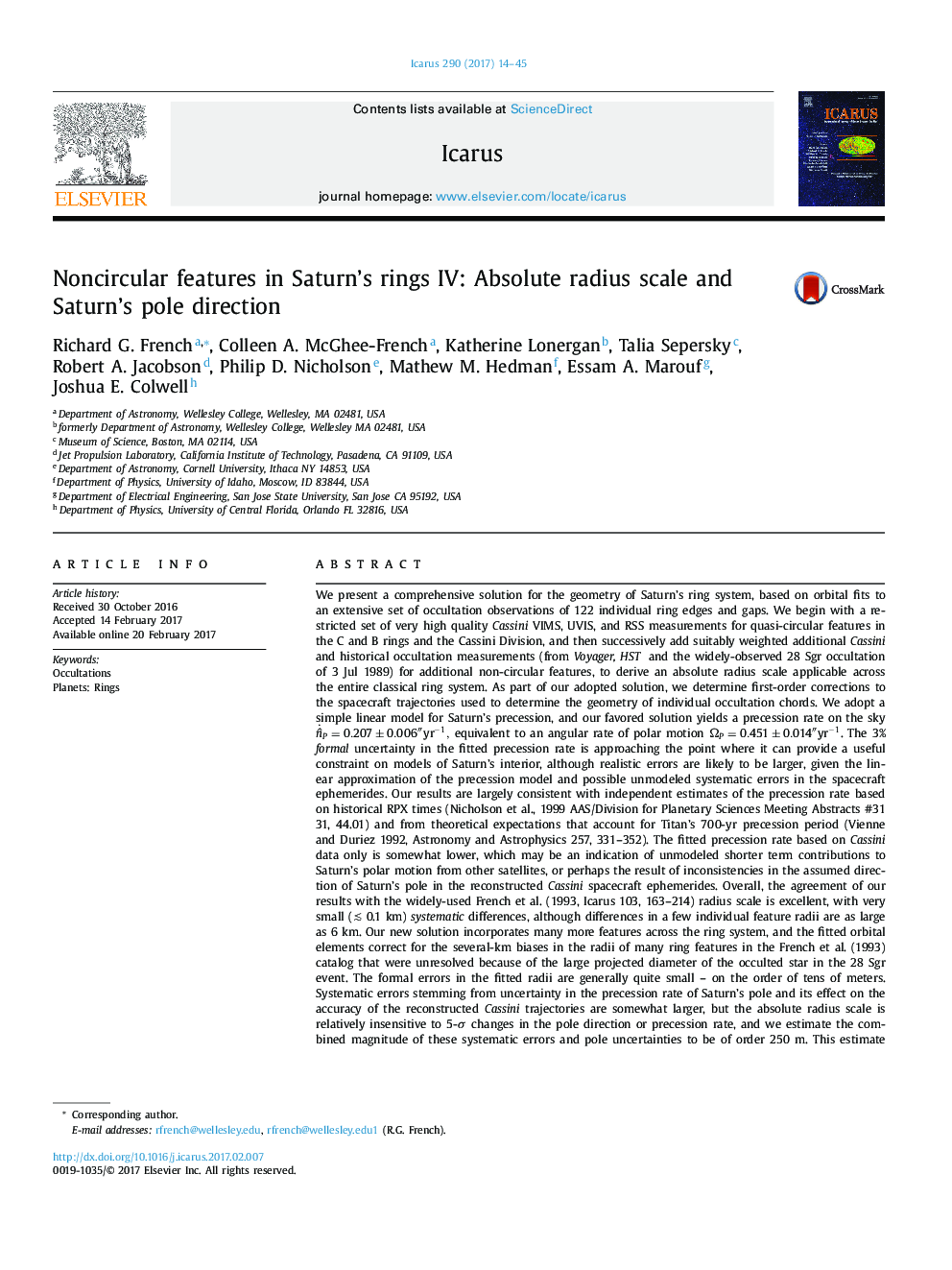| کد مقاله | کد نشریه | سال انتشار | مقاله انگلیسی | نسخه تمام متن |
|---|---|---|---|---|
| 5487032 | 1523501 | 2017 | 32 صفحه PDF | دانلود رایگان |
عنوان انگلیسی مقاله ISI
Noncircular features in Saturn's rings IV: Absolute radius scale and Saturn's pole direction
دانلود مقاله + سفارش ترجمه
دانلود مقاله ISI انگلیسی
رایگان برای ایرانیان
کلمات کلیدی
موضوعات مرتبط
مهندسی و علوم پایه
علوم زمین و سیارات
علوم فضا و نجوم
پیش نمایش صفحه اول مقاله

چکیده انگلیسی
We present a comprehensive solution for the geometry of Saturn's ring system, based on orbital fits to an extensive set of occultation observations of 122 individual ring edges and gaps. We begin with a restricted set of very high quality Cassini VIMS, UVIS, and RSS measurements for quasi-circular features in the C and B rings and the Cassini Division, and then successively add suitably weighted additional Cassini and historical occultation measurements (from Voyager, HST and the widely-observed 28 Sgr occultation of 3 Jul 1989) for additional non-circular features, to derive an absolute radius scale applicable across the entire classical ring system. As part of our adopted solution, we determine first-order corrections to the spacecraft trajectories used to determine the geometry of individual occultation chords. We adopt a simple linear model for Saturn's precession, and our favored solution yields a precession rate on the sky n^ËP=0.207±0.006â²â²yrâ1, equivalent to an angular rate of polar motion ΩP=0.451±0.014â²â²yrâ1. The 3% formal uncertainty in the fitted precession rate is approaching the point where it can provide a useful constraint on models of Saturn's interior, although realistic errors are likely to be larger, given the linear approximation of the precession model and possible unmodeled systematic errors in the spacecraft ephemerides. Our results are largely consistent with independent estimates of the precession rate based on historical RPX times (Nicholson et al., 1999 AAS/Division for Planetary Sciences Meeting s #31 31, 44.01) and from theoretical expectations that account for Titan's 700-yr precession period (Vienne and Duriez 1992, Astronomy and Astrophysics 257, 331-352). The fitted precession rate based on Cassini data only is somewhat lower, which may be an indication of unmodeled shorter term contributions to Saturn's polar motion from other satellites, or perhaps the result of inconsistencies in the assumed direction of Saturn's pole in the reconstructed Cassini spacecraft ephemerides. Overall, the agreement of our results with the widely-used French et al. (1993, Icarus 103, 163-214) radius scale is excellent, with very small (â² 0.1 km) systematic differences, although differences in a few individual feature radii are as large as 6 km. Our new solution incorporates many more features across the ring system, and the fitted orbital elements correct for the several-km biases in the radii of many ring features in the French et al. (1993) catalog that were unresolved because of the large projected diameter of the occulted star in the 28 Sgr event. The formal errors in the fitted radii are generally quite small - on the order of tens of meters. Systematic errors stemming from uncertainty in the precession rate of Saturn's pole and its effect on the accuracy of the reconstructed Cassini trajectories are somewhat larger, but the absolute radius scale is relatively insensitive to 5-Ï changes in the pole direction or precession rate, and we estimate the combined magnitude of these systematic errors and pole uncertainties to be of order 250 m. This estimate is likely to be improved once a new set of reconstructed Cassini trajectories has been developed, based on a self-consistent model for Saturn's pole. We demonstrate the utility of the new radius scale and the associated trajectory corrections in the analysis of short-wavelength density waves in the C ring. In online supplementary material, we provide in machine-readable form the more than 15,000 individual ring measurements used in this study, as well as details of the ring orbit fits underlying this work.
ناشر
Database: Elsevier - ScienceDirect (ساینس دایرکت)
Journal: Icarus - Volume 290, 1 July 2017, Pages 14-45
Journal: Icarus - Volume 290, 1 July 2017, Pages 14-45
نویسندگان
Richard G. French, Colleen A. McGhee-French, Katherine Lonergan, Talia Sepersky, Robert A. Jacobson, Philip D. Nicholson, Mathew M. Hedman, Essam A. Marouf, Joshua E. Colwell,